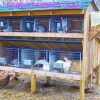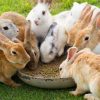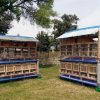
Breeding Rabbits – Comprehensive Report On Raising Quality Rabbits (Mating – Pregnancy – Litters)
Introduction
This days, rabbit business is one popular business that is on the rise, with almost every farmer and individual wanting to venture into. This is because it is relatively inexpensive to obtain and easy to maintain.
Its legendary desire to reproduce and its unmatched cleanliness is every reason to keep one or more rabbits in your backyard. However, above all reasons, the domestic backyard rabbit is very good and hygenic to eat.
The white meat of rabbits is nutritious and very palatable, and easy to digest since it contains little fat.
Apart from the chicken, there is no other domestic animal that can produce as much edible meat as the rabbit.
One doe, in one hutch can produce up to (32 to 43 kg) of dressed edible meat each year.
Do you know that RABBIT MEAT is best for Dieting and Healthy Living?
BEST LOCATION TO REAR RABBITS
Ease in cleaning and convenience in feeding are important in selecting a site for the hutch (pen).
Locate the hutch (pen) where the rabbits are protected from wind, rain and excessive sun.
It is true that sunlight helps to keep the hutch sanitary, however, it is equally important to provide the animals with shade.
THE HUTCH / CAGE (PEN)
The hutch (pen) you provide for your rabbit must be comfortable. The outdoor hutch should be constructed of wood and wire. The roof should be covered with wood before the galvanized metal sheet is nailed on. This is very important since the wood greatly reduces the heat in the hutch.
The smaller gauge wire on the floor allows most of the droppings to fall through and reduces the danger of young rabbits getting their hocks caught in the floor.
“Do not build a covered box, since these are damp and dampness can be fatal to young rabbits.”

BEDDING
Shavings, dried grass or dried sour grass are good bedding material. Be sure that the grass is very dry before it is placed in the box otherwise the grass can sweat and grow a fungus (mold) which is very hazardous to the health of young rabbits.
EQUIPMENT
Rabbit bowls are commonly used for feeding. You can also get ceramic made bowls which would make it impossible for the rabbits to chew, or spill away the food!
A word of caution, once these containers begin to rust it is advisable to dispose of them and use new ones. Similar pans can be used for watering dishes. For those who desire, self feeders can be purchased from your local feed dealer. It is recommended that a loop of wire be tied around the pans and fastened to the side or front of the hutch to prevent the rabbit from overturning either or both pans and thus spilling their feed and/or water. It is advisable not to use plastic containers since rabbits like to chew on equipment and the swallowed pieces of plastic can be very harmful. Remember rabbits must have an ample supply of clean fresh water available at all times.
There are other advantages to keep rabbits. They help your gar-den to produce more. Rabbit manure contains high proportions of nitrogen and phosphorous and potash. The manure will not burn plants, even when applied fresh. It comes in a convenient, easy to handle, dry form, ready to be used. This manure is great for growing almost anything.
Your garden can help your rabbits to produce more. The leaves of the cabbage, lettuce and carrot plants are good food from them.
RABBITS – FEEDS AND FEEDING
Rabbit producers tend to feed their animals either forages (grasses and legumes gathered from the side of the road or from an open pasture) or commercially prepared pellets.
There is nothing wrong with either feeding method since both methods if handled properly will provide the rabbit with an adequate nutritional diet to meet their requirements for maintenance, growth, reproduction and lactation. However, the problem faced daily is the high cost of commercial rabbit pellets and the inconsistent supply of local quality grasses and legumes.
The objective of this fact sheet is to help the West Indian rabbit producer combine both local grasses and legumes with concentrate into a feeding system that will promote maximum litter size, high milk production in the mothering doe and maximum growth (weight gain) of young rabbits that are raised for meat.
Commercially prepared pelleted rabbit feeds meet all of the nutritional requirements of these animals; however, it seems that insufficient advantage is taken of the high quality native legumes and grasses found throughout the region. These local forages are excellent feed stuffs and can supply the nutritional requirements of dry does, herd bucks and replacement animals if cut and fed in the right combination and at the correct stage of maturity. Unfortunately native grasses and legumes are not nutritious enough to meet the protein, energy and vitamin requirements of pregnant does and suckling litters.
These animals need more of those nutrients that can be found in the best combination of grasses and legumes and should be fed local forages plus a measured portion of rabbit pellets (or a commercial concentrate).
Common rabbit breeds found in Nigerian farms (Updated February 2022)
NEST BOX
Such combinations provide adequate levels of the essential nutrients which will enable the doe to produce all of the milk required by her nursing Utter to support maximum growth and development.
FEEDS COMMERCIAL
- PELLETS – Should be fed to the pregnant does with suckling litters. If there are no commercial rabbit feeds available then purchase the multi-purpose balance animals feed and feed it to the pregnant and suckling does.
- FORAGE – When collecting forage for rabbits it takes no more time to select the best quality legumes and grasses, so be selective. Remember the better the quality the less the rabbit will need to provide all of those necessary nutrients. Look for grasses and legumes that are young and tender.
This is the growing stage when forages are most nutritious.
Examples of forages for feed:
- GRASSES
- Guinea grass (Panicum maximum)
- Pangola grass (Digitaria decumbens)
- Devil’s grass (Cynodon dactylon)
- Pond grass (Commelina elegans)
- Antigua hay grass (Dicanthium aristatum)
- Elephant grass (Pennisetum purpureum)
- LEGUMES
- Rabbit vine (Teramnus labialis)
- Blue pea (Clitoria ternatea)
- River Tamarind (Leucaena leucocephala)
- Sweet potato vines (Ipomoea battatus)
- Pigeon pea husks (Cajanus cajan)
- SALT – It is a good idea to keep a little salt in each hutch so that the rabbit may satisfy its own needs.
Salt is a very important nutrient and without adequate quantities in their diet young rabbits will not grow properly, suckling does will not produce enough milk to nourish their litter and breeding bucks will be very poor breeders.
- WATER – Keep clean, fresh water before the rabbit at all times. Without water the suckling doe will not produce enough milk and the growing animals will not eat enough feed to grow as quickly as they should.
FEEDING AND MILKING DOES AND LITTERS
Feed four to six ounces (115 to 170g) of commercial rabbit pellets to the doe at the time of kindling; slowly increase this quantity until the doe is getting all she can eat at the end of one week.
Does normally eat between eight ounces and one pound (230 to 454g) of pellets daily until the litter is three (3) weeks old. The quantity of feed eaten daily by the doe will be dictated by her size, (whether she is a medium or large breed) and the number of young in the litter.
After three weeks the doe and her litter may consume up to three pounds (1.35kg) every day.
However, by providing the doe with fresh, young, green, forages the daily consumption of pellets would be approximately half, or four to eight ounces (115 to 230g) in the first three weeks and 1.5 pounds (680g) after three weeks of kindling.
At weaning time the pellets fed to heavy milking does should be reduced to two or three ounces (55 to 85g) immediately and fed at that rate until her milk has dried up.
MATURE BUCKS AND RESTING DOES
These animals should have free access to good quality green forages daily. If the grasses and legumes fed are of poor quality and dry then they should be given one to two ounces (30 to 60g) of rabbit pellets along with their daily forage.
To bring heavy producing does, (that is does which have produced litters above average weight and numbers), back into condition it may be necessary to feed them more than one to two ounces (30 to 60g) pellets. In such cases let your eyes and hands be the judge.
Observe the doe regularly and heft her to see if she is regaining the weight she lost while nursing her last litter.
PREGNANT DOES
Pregnant does should not become overfat; do not feed more than three to four ounces (80 to 115g) of pellets daily. However if the grass and legume forages fed is good quality then the quantity of pellets fed can be reduced to 1.5 to two ounces (45 to 60g) daily.
GROWING RABBITS
Growing rabbits should be given all the commercial pellets and young, green, forages they can eat. Like with the nursing doe, if the forage is poor quality then the growing rabbits should be given more pellets. Actually the best feeding practice is to have commercial rabbit pellets in front of the young animals at all times.
Forages alone will not allow you to produce a finished rabbit for eating quickly enough.
RABBIT MEAT PRESERVATION
Rabbit meat can be stored in the freezer for four to six months; cooked rabbit, about two months. There are also many ways of preparing rabbit meat.
Most practice in Nigeria is : You can first boil and then fry to keep the meat whole and firm. It can then be refrigerated to preserve for a longer period.



